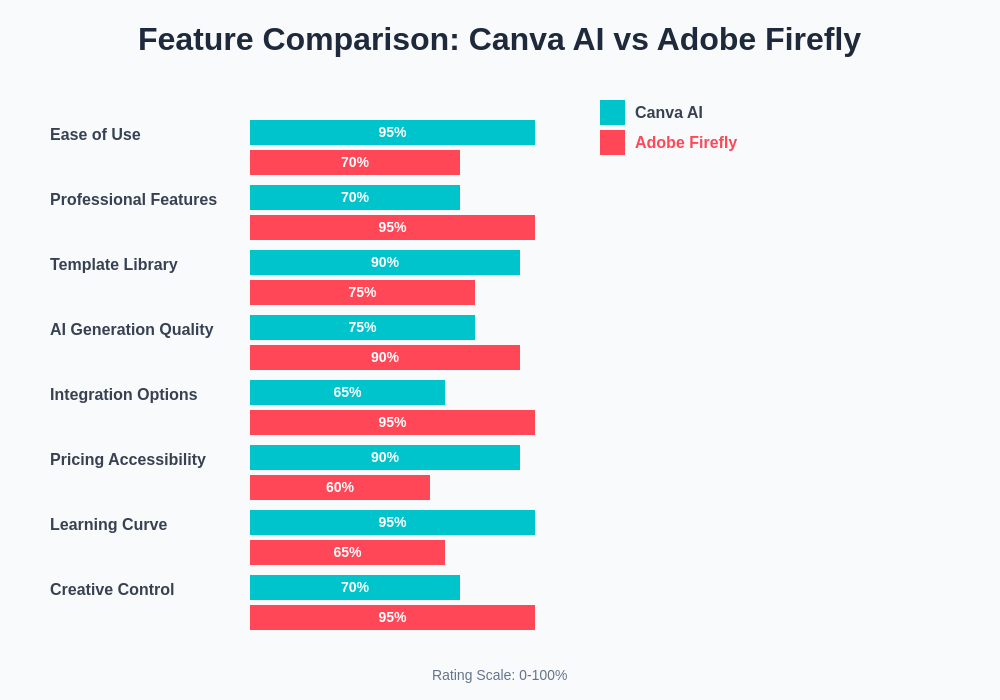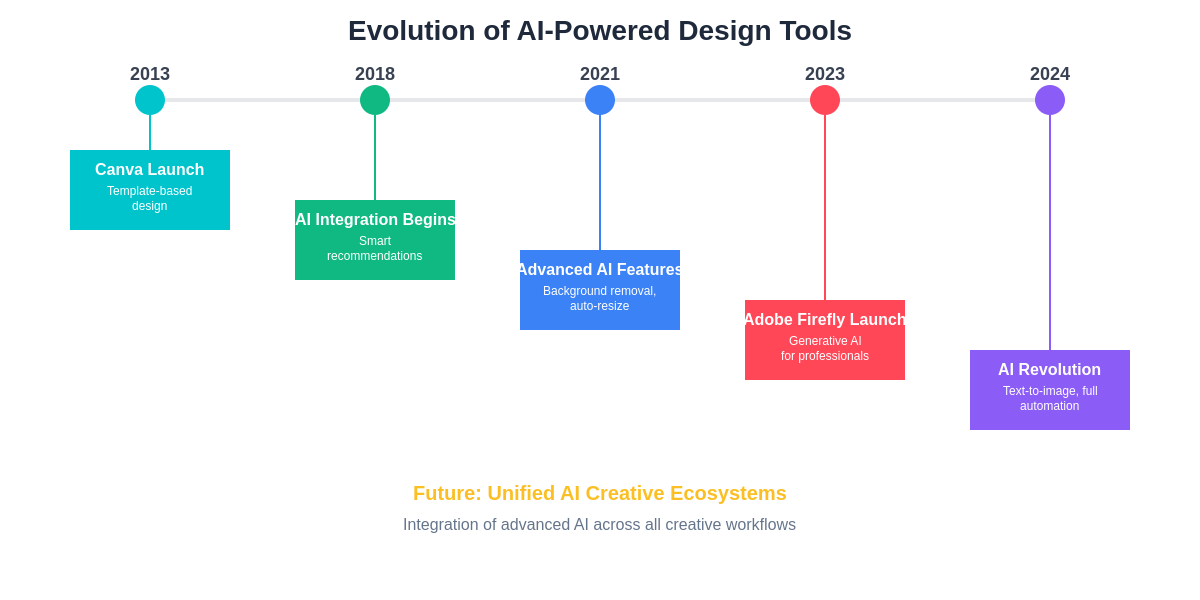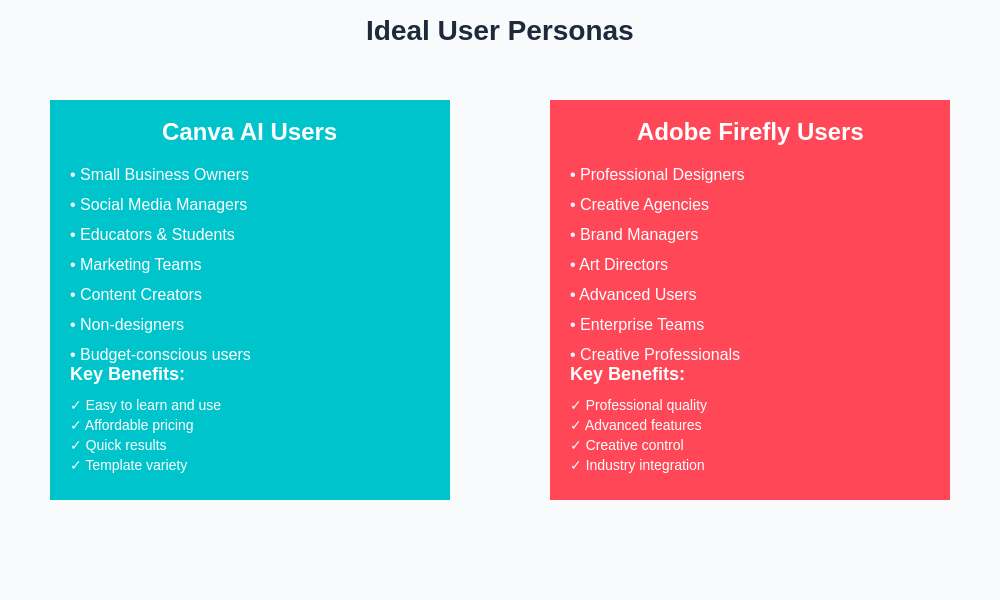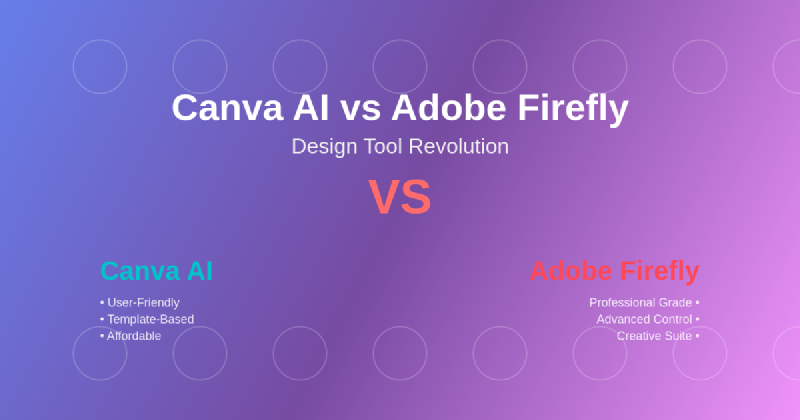The digital design landscape has experienced an unprecedented transformation with the emergence of artificial intelligence-powered creative tools, fundamentally altering how designers, marketers, and content creators approach visual communication. At the epicenter of this revolution stand two technological giants: Canva AI and Adobe Firefly, each representing distinct philosophies and approaches to democratizing design through intelligent automation and creative assistance.
Explore the latest AI design trends and innovations to understand how these revolutionary tools are reshaping the creative industry and empowering millions of users worldwide to produce professional-quality designs without traditional design expertise. The competition between these platforms transcends simple feature comparisons, representing a fundamental shift in how creative work is conceived, executed, and refined in the modern digital ecosystem.
The Genesis of AI-Powered Design
The emergence of AI-powered design tools represents a culmination of decades of technological advancement in machine learning, computer vision, and natural language processing. Canva AI and Adobe Firefly each emerged from different organizational contexts and design philosophies, yet both share the common goal of making sophisticated design capabilities accessible to users regardless of their technical expertise or formal design training.
Canva AI evolved from the company’s mission to democratize design by building upon their established platform of user-friendly templates and drag-and-drop functionality. The integration of artificial intelligence into Canva’s ecosystem represents a natural progression toward even greater accessibility, enabling users to generate custom graphics, suggest design improvements, and automate repetitive creative tasks through intuitive text prompts and intelligent assistance.
Adobe Firefly emerged from Adobe’s extensive experience in professional creative software development, representing the company’s commitment to integrating cutting-edge AI capabilities into their comprehensive suite of design tools. Built upon Adobe’s vast repository of creative assets and deep understanding of professional design workflows, Firefly aims to enhance rather than replace traditional design processes while maintaining the sophistication and precision that professional designers demand.
Platform Philosophy and Target Audience
The fundamental differences between Canva AI and Adobe Firefly become apparent when examining their respective target audiences and design philosophies. Canva AI maintains its commitment to accessibility and ease of use, targeting small business owners, social media managers, educators, and individuals who need to create professional-looking designs without extensive design knowledge or significant time investment.
This accessibility-first approach is reflected in Canva AI’s interface design, feature organization, and pricing structure, all of which prioritize simplicity and immediate usability over advanced customization options. The platform excels at helping users quickly produce visually appealing content for social media, presentations, marketing materials, and educational resources through guided workflows and intelligent suggestions that eliminate many of the complexities traditionally associated with graphic design.
Adobe Firefly, conversely, targets professional designers, creative agencies, and advanced users who require sophisticated control over their creative output while benefiting from AI-powered efficiency improvements. The platform integrates seamlessly with Adobe’s existing Creative Suite applications, providing AI enhancement capabilities that complement rather than replace traditional design tools and workflows.
Discover advanced AI capabilities with Claude for creative projects that require sophisticated reasoning and detailed creative guidance. The professional focus of Adobe Firefly is evident in its emphasis on maintaining creative control, offering granular customization options, and providing tools that enhance rather than automate the creative decision-making process.
Feature Comparison and Capabilities
The feature sets of Canva AI and Adobe Firefly reflect their different approaches to AI-powered design assistance, with each platform offering unique strengths and capabilities tailored to their respective target audiences. Canva AI excels in providing comprehensive template-based solutions, intelligent design suggestions, and automated content generation that enables users to create polished designs with minimal manual intervention.
Canva AI’s strength lies in its ability to understand user intent through natural language prompts and automatically generate appropriate design elements, color schemes, and layouts that align with current design trends and best practices. The platform’s AI-powered features include intelligent background removal, automatic photo enhancement, smart resizing for multiple platforms, and content-aware design suggestions that adapt to different use cases and brand requirements.
Adobe Firefly distinguishes itself through its sophisticated generative capabilities and seamless integration with professional design workflows. The platform excels at creating high-quality custom imagery, generating complex visual effects, and providing precise control over AI-generated content through detailed prompting and extensive customization options that professional designers require.
The technical sophistication of Adobe Firefly’s AI models enables more nuanced creative control, allowing users to specify exact stylistic requirements, adjust generation parameters, and iterate on designs with greater precision than typically possible with consumer-focused AI design tools. This level of control makes Adobe Firefly particularly valuable for professional projects where brand consistency, creative originality, and technical precision are paramount.
User Experience and Interface Design
The user experience philosophies of Canva AI and Adobe Firefly reflect their different approaches to balancing simplicity with functionality. Canva AI maintains its signature intuitive interface while seamlessly integrating AI-powered features into familiar workflows, ensuring that new users can immediately benefit from intelligent assistance without needing to learn complex new interaction patterns.
The platform’s approach to AI integration emphasizes discoverability and ease of use, with AI features presented as natural extensions of existing design tools rather than separate, complex systems requiring specialized knowledge. This integration strategy ensures that users can gradually adopt AI capabilities at their own pace while continuing to rely on familiar design processes and workflows.
Adobe Firefly takes a more sophisticated approach to user interface design, providing extensive customization options and detailed control panels that enable professional users to fine-tune AI-generated content according to their specific requirements. The interface design assumes greater user expertise while providing comprehensive guidance and documentation for users who need to understand the technical aspects of AI-powered design generation.
The learning curve for Adobe Firefly is necessarily steeper due to its extensive feature set and professional focus, but this complexity enables more sophisticated creative outcomes and greater integration with existing professional design workflows. Users willing to invest time in learning the platform’s capabilities can achieve results that closely match their creative vision while benefiting from significant efficiency improvements.
Content Generation and Creative Capabilities
The content generation capabilities of both platforms represent significant advances in AI-powered creativity, though each excels in different areas and serves different creative needs. Canva AI focuses on practical, immediately usable content generation that enables users to quickly produce social media graphics, presentations, marketing materials, and other common design deliverables without extensive creative input or technical expertise.
The platform’s AI models are optimized for generating visually appealing, on-brand content that aligns with current design trends and best practices across various industries and use cases. This optimization ensures that even users with limited design experience can produce professional-quality results that effectively communicate their intended messages while maintaining visual consistency and appeal.
Adobe Firefly’s content generation capabilities emphasize creative flexibility and artistic sophistication, enabling users to produce highly customized imagery, complex visual effects, and unique artistic elements that can be seamlessly integrated into professional design projects. The platform’s generative AI models are trained on Adobe’s extensive library of professional creative assets, ensuring high quality output that meets professional standards.
The creative control offered by Adobe Firefly enables users to specify detailed artistic requirements, experiment with different stylistic approaches, and iterate on generated content with precision that supports professional creative workflows. This level of control makes the platform particularly valuable for projects requiring original, high-quality visual content that aligns with specific brand guidelines and creative objectives.
Enhance your research and creative process with Perplexity for comprehensive information gathering and trend analysis that inform your design decisions and creative strategies.
Integration and Workflow Efficiency
The integration capabilities of Canva AI and Adobe Firefly reflect their different approaches to workflow optimization and platform ecosystem development. Canva AI emphasizes standalone functionality while providing integration options that enable users to incorporate their designs into various external platforms and workflows without requiring additional software or technical expertise.
The platform’s approach to integration focuses on practical utility, offering direct publishing capabilities for social media platforms, email marketing services, and presentation software that streamline the process of moving from design creation to content distribution. This integration strategy supports the platform’s accessibility mission by eliminating technical barriers that might prevent users from effectively utilizing their created content.
Adobe Firefly’s integration strategy centers on seamless compatibility with Adobe’s extensive Creative Suite ecosystem, enabling professional designers to incorporate AI-generated content into complex, multi-application workflows without disrupting established creative processes. This deep integration allows users to leverage AI capabilities while maintaining access to the full range of professional design tools and features they require.
The workflow efficiency improvements offered by Adobe Firefly are particularly significant for professional users who regularly work with multiple Adobe applications, as AI-generated content can be automatically optimized for specific use cases and seamlessly transferred between applications while maintaining quality and compatibility with existing project requirements.
Pricing Models and Accessibility
The pricing strategies of Canva AI and Adobe Firefly reflect their different target audiences and value propositions, with each platform offering subscription models designed to align with their users’ needs and budget constraints. Canva AI maintains its commitment to accessibility through a freemium model that provides substantial functionality at no cost while offering premium features through affordable subscription tiers.
This pricing approach enables individual users, small businesses, and educational institutions to access AI-powered design capabilities without significant financial investment, supporting the platform’s mission of democratizing professional-quality design tools. The premium subscription tiers offer additional AI generation credits, advanced features, and expanded template libraries while remaining accessible to non-enterprise users.
Adobe Firefly’s pricing model reflects its professional focus and integration with Adobe’s broader Creative Suite ecosystem. The platform is available through Adobe’s existing subscription plans, with AI capabilities included as part of comprehensive creative software packages that provide access to multiple professional applications and services.
While Adobe Firefly’s pricing is higher than Canva AI’s offerings, the cost is justified by the platform’s sophisticated capabilities, professional-grade output quality, and comprehensive integration with industry-standard creative tools that professional designers and creative agencies require for their work.
Performance and Output Quality
The performance characteristics and output quality of both platforms represent significant achievements in AI-powered content generation, though each excels in different aspects of creative production. Canva AI prioritizes speed and consistency, enabling users to quickly generate multiple design variations and iterate on concepts without significant wait times or technical complications.
The platform’s AI models are optimized for producing visually appealing results that meet common design requirements across various use cases, ensuring that users can reliably generate professional-looking content that serves their immediate needs. This optimization approach means that while individual outputs may not achieve the same level of artistic sophistication as more complex tools, the consistency and reliability of results make the platform highly effective for its intended use cases.
Adobe Firefly emphasizes output quality and creative sophistication, with AI models capable of generating high-resolution imagery and complex visual effects that meet professional standards for print and digital media. The platform’s focus on quality over speed means that generation times may be longer, but the resulting content typically exhibits greater artistic merit and technical precision.
The professional focus of Adobe Firefly is evident in its attention to technical details such as color accuracy, resolution optimization, and compatibility with professional printing and digital distribution requirements. These technical considerations make the platform particularly valuable for projects where output quality and technical specifications are critical success factors.
Creative Control and Customization
The level of creative control offered by each platform reflects their different approaches to balancing automation with user agency in the creative process. Canva AI emphasizes guided creativity, providing intelligent suggestions and automated optimizations while maintaining user control over key design decisions and brand elements.
This approach enables users to benefit from AI assistance while retaining ownership of their creative vision, ensuring that generated content aligns with their specific requirements and brand guidelines. The platform’s AI features are designed to enhance rather than replace human creativity, providing suggestions and automation that support user decision-making rather than making autonomous creative choices.
Adobe Firefly provides extensive granular control over AI-generated content, enabling professional users to specify detailed parameters, adjust generation settings, and iteratively refine outputs to match their precise creative requirements. This level of control supports complex creative workflows while enabling users to maintain artistic ownership and creative authenticity.
The customization capabilities of Adobe Firefly extend beyond basic parameter adjustment to include style training, custom model fine-tuning, and integration with existing brand asset libraries that ensure generated content maintains consistency with established creative standards and brand guidelines.
Future Development and Innovation Trajectory
The future development trajectories of Canva AI and Adobe Firefly suggest continued evolution in different directions, with each platform likely to enhance its core strengths while addressing current limitations. Canva AI’s development roadmap appears focused on expanding accessibility and ease of use while gradually adding more sophisticated capabilities that maintain the platform’s user-friendly approach.
Expected developments in Canva AI include enhanced natural language processing for more intuitive design requests, improved integration with external platforms and services, and expanded template libraries that cover emerging design trends and use cases. The platform is likely to continue prioritizing features that enable non-designers to produce professional-quality results while maintaining its commitment to accessibility and affordability.
Adobe Firefly’s future development is likely to focus on advancing the sophistication of its AI models, expanding integration capabilities within the Creative Suite ecosystem, and providing even greater creative control and customization options for professional users. The platform’s development trajectory suggests continued emphasis on maintaining creative authenticity while leveraging AI to enhance productivity and creative exploration.
Both platforms are likely to benefit from ongoing advances in AI technology, with improvements in generation speed, output quality, and creative capabilities that will further transform the digital design landscape and provide even greater value to their respective user communities.

The comprehensive feature comparison between these platforms reveals distinct strengths and focus areas that align with their respective target audiences and design philosophies. Understanding these differences enables users to make informed decisions about which platform best serves their specific creative needs and workflow requirements.

The evolution of AI-powered design tools represents a broader transformation in creative industries, with both Canva AI and Adobe Firefly playing crucial roles in defining the future of digital design and creative expression.

The distinct user personas served by each platform highlight the importance of choosing tools that align with specific professional requirements, skill levels, and creative objectives in the modern design landscape.
Conclusion and Recommendations
The choice between Canva AI and Adobe Firefly ultimately depends on specific user needs, technical requirements, and creative objectives. Canva AI excels as an accessible, user-friendly platform that enables individuals and small businesses to produce professional-quality designs without extensive design expertise or significant time investment. Its strength lies in democratizing design capabilities while maintaining simplicity and affordability.
Adobe Firefly serves professional designers and creative agencies who require sophisticated AI capabilities integrated with comprehensive creative tools and workflows. Its emphasis on quality, control, and professional integration makes it ideal for complex projects where creative precision and technical specifications are paramount.
Both platforms represent significant advances in AI-powered creativity and will continue to evolve as technology advances and user needs develop. The competition between these platforms ultimately benefits the entire creative community by driving innovation, improving accessibility, and expanding the possibilities for AI-assisted creative expression.
Disclaimer
This article provides informational analysis of AI-powered design tools and does not constitute professional advice. Users should evaluate their specific requirements and consider trial periods or demonstrations before making software purchasing decisions. The effectiveness of these tools may vary based on individual use cases, technical requirements, and creative objectives. All product features, pricing, and capabilities mentioned are subject to change by the respective companies.
